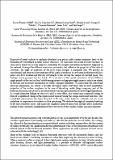Por favor, use este identificador para citar o enlazar a este item:
http://hdl.handle.net/10261/207123COMPARTIR / EXPORTAR:
 SHARE SHARE
 CORE
BASE CORE
BASE
|
|
| Visualizar otros formatos: MARC | Dublin Core | RDF | ORE | MODS | METS | DIDL | DATACITE | |

| Título: | Tuning the period of femtosecond laser induced surface structures in steel: From angled incidence to quill writing |
Autor: | Fuentes-Edfuf, Yasser CSIC ORCID; Sánchez-Gil, José A. CSIC ORCID ; Garcia-Pardo, Marina CSIC ORCID; Serna, Rosalía CSIC ORCID ; Tsibidis, G. D.; Giannini, V. CSIC ORCID; Solís Céspedes, Javier CSIC ORCID ; Siegel, Jan CSIC ORCID | Palabras clave: | Femtosecond laser Laser-induced periodic surface structure LIPSS Surface plasmon polariton Quill writing Roughne |
Fecha de publicación: | 15-jul-2019 | Editor: | Elsevier BV | Citación: | Applied Surface Science 493: 948-955 (2019) | Resumen: | Exposure of metal surfaces to multiple ultrashort laser pulses under certain conditions leads to the formation of well-defined periodic surface structures. We show how the period of such structures in steel can be tuned over a wide range by controlling the complex interaction mechanisms triggered in the material. Amongst the different irradiation parameters that influence the properties of the induced structures, the angle of incidence of the laser beam occupies a prominent role. We present an experimental and theoretical investigation of this angle dependence in steel upon irradiation with laser pulses of 120¿fs duration and 800¿nm wavelength, while moving the sample at constant speed. Our findings can be grouped into two blocks. First, we observe the spatial coexistence of two different ripple periods at the steel surface, both featuring inverse scaling upon angle increase, which are related to forward and backward propagation of surface plasmon polaritons. To understand the underlying physical phenomena, we extend a recently developed model that takes into account quantitative properties of the surface roughness to the case of absorbing metals (large imaginary part of the dielectric function), and obtain an excellent match with the experimentally observed angle dependence. As second important finding, we observe a quill writing effect, also termed non-reciprocal writing, in form of a significant change of the ripple period upon reversing the sample movement direction. This remarkable phenomenon has been observed so far only inside dielectric materials and our work underlines its importance also in laser surface processing. We attribute the origin of symmetry breaking to the non-symmetric micro- and nanoscale roughness induced upon static multiple pulse irradiation, leading to non-symmetric modification of the wavevector of the coupled surface plasmon polariton. | Descripción: | 8 pags., 8 figs., 1 app. | Versión del editor: | http://dx.doi.org/10.1016/j.apsusc.2019.07.106 | URI: | http://hdl.handle.net/10261/207123 | DOI: | 10.1016/j.apsusc.2019.07.106 | Identificadores: | doi: 10.1016/j.apsusc.2019.07.106 issn: 0169-4332 |
| Aparece en las colecciones: | (CFMAC-IO) Artículos (CFMAC-IEM) Artículos |
Ficheros en este ítem:
| Fichero | Descripción | Tamaño | Formato | |
|---|---|---|---|---|
| Tuning the period of femtosecond .pdf | 1,32 MB | Adobe PDF |  Visualizar/Abrir |
CORE Recommender
SCOPUSTM
Citations
29
checked on 11-abr-2024
WEB OF SCIENCETM
Citations
28
checked on 23-feb-2024
Page view(s)
159
checked on 22-abr-2024
Download(s)
79
checked on 22-abr-2024
Google ScholarTM
Check
Altmetric
Altmetric
NOTA: Los ítems de Digital.CSIC están protegidos por copyright, con todos los derechos reservados, a menos que se indique lo contrario.
